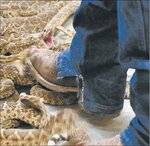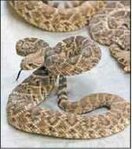


Mark Pyle has been studying snakes with a passion for most of his life.
“I have always had an interest in snakes,” the 45-year-old Hood County resident said. “Everyone else was afraid of them so I wanted to know why. That is when I discovered there wasn’t a real reason to fear them.”
Pyle became the education director of the North Texas Herpetological Society in the late 1990s.
He is now president of the Dallas-Fort Worth Herpetological Society.
Many people are terrified of snakes, especially rattlesnakes. Should they be?
There is no logical reason for anyone to be terrified of any snake. Some people have a phobia of snakes that will cause them to be terrified of something. Phobias are psychological not logical. They do need to be respected. They can cause serious injury or possible death.
What should you do if you’re bitten by a snake? By a rattlesnake?
If you are bitten by a known non-venomous snake you should treat it like any other small injury. If you are bitten by an unknown snake, treat it like a venomous snake until proven that it isn’t. If you are bitten by a known venomous snake, the most important things are to get medical attention and remain calm. It is also important to remove whatever you have on that limb like a shoe or ring because you will most likely have swelling. Mark the bite and write the time of the bite. Then mark the swelling/pain every 15 minutes. This will help the ER determine the severity of the bite. Do not suck, shock, cut, use ice or drink alcohol. You do not need to know the species for treatment with any pit viper (rattlesnake, copperhead, cottonmouth) bite.
Have you ever been bitten by a snake? A rattlesnake?
I have been bitten by a lot of non-venomous snakes. I have never been bitten by a venomous snake.
When and where would people most likely encounter rattlesnakes?
Rattlesnakes are the most active during the spring and fall. The spring and fall are also the time people like to be outside. This brings both snakes and people together. I don’t have any statistics that show where people encounter rattlesnake the most.
What are the best precautions from being bit by a rattlesnake?
The best way to avoid a bit is to not get close enough to be bitten. You can do this in several ways. Watching where you put your hands and feet will help you avoid a close encounter. If you see a venomous snake from a distance that is farther the snake can strike, the snake is no danger to you no matter how big. They do not chase people. They will flee at the first chance they get when they feel safe doing so. I would also advise using a rake to move leaf-litter. Again if you see the snake first, you are safe. The rake will cause the snake to move and make itself visible if it is well camouflaged. Never attempt to kill a snake. Many people are injured trying to kill a snake. They put themselves in a position that is within striking distance before they realize it. Bystanders have also been killed by bullets fired at snakes. A sheriff’s deputy killed a young boy trying to shoot a cottonmouth that ended up being a water snake. That is just one example.
What’s the largest rattlesnake you’ve seen?
In North Texas rattlesnakes tend not to get really large. However in Cedar Hill they are known to get above average for North Texas. Most are around 2.5 feet to 3 feet long. The largest I have seen while in the field was one around 6 feet long in Cedar Hill.
We have heard that rattlesnakes are evolving without rattles on their tails. True?
They already have. The Catalina Island rattlesnake does not have a rattle. This took a very long time. This may have been because it had no predators or other threats to warn. I have heard a myth that western diamond-backed rattlesnakes are not using their rattle because of hogs. This simple isn’t true. They normally don’t rattle unless they know the perceived threat knows they are there. They have been doing this for a very long time. It would also take thousands of years for them to evolve away from having a rattle that took thousands of years to create. The pygmy rattlesnake is a very small rattlesnake that has a tiny rattle that you really wouldn’t hear outside in most conditions. There is evidence that they may be in the process of losing their rattle but this is a very slow process.
editor@hcnews.com | 817-573-7066, ext. 245